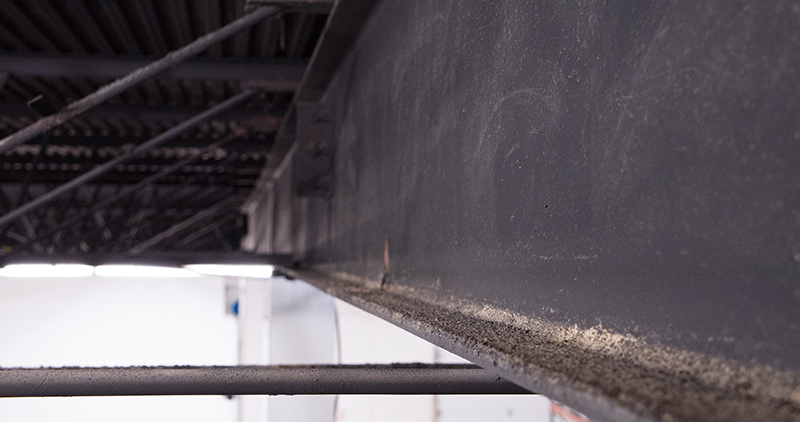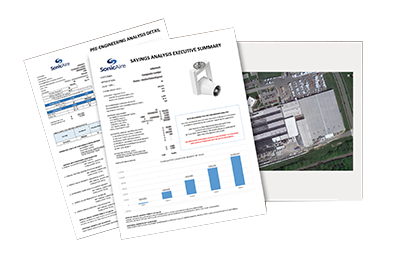Combustible Dust, One in a Litany of Hazards
In production and processing facilities, dangers seem to be lurking around every corner.
At least that’s the way it feels when you enter a facility full of loud, whirring machinery. Yellow paint lines the concrete floors. Employees are wearing hard hats and steel toe boots. Forklifts move around the facility, lifting, shifting, and moving equipment. Wire mesh blocks off areas with automated equipment.
Facilities regularly put rules in place to keep employees safe and minimize incidents. Some of these have become so commonplace, we barely think about them.
- Hard hats, steel toe boots, and ear protection keep the day-to-day and minor incidents from causing significant harm.
- Wire cages block off dangerous equipment.
- Yellow paint or tape indicates the places where it’s safe to stand and move.
- Railings prevent people from falling.
- Fire Exits identify the best way to escape in an emergency.

It’s easy to forget that things were not always this way. In 1973, there were 11 recordable cases of workplace injury and illness for every 100 workers. That means employees were four times more likely to be injured or ill on the job than today.
For 2019, the Bureau of Labor Statistics reports there were 2.8 recorded incidents per 100 workers for a total of 2.8 million nonfatal injuries and illnesses. That’s 20% fewer incidents per 100 FTE than reported in 2010. Manufacturing alone represented 15% of all nonfatal injuries and illnesses reported, with 421,400 cases reported.
Sadly, there were still 5,333 fatalities in the workplace in 2019. But the preventable death rate, measured by deaths per 100,000 workers, has dropped by 25% since 1992.
The reduction in workplace injuries and fatalities is undoubtedly because of plants and facilities implementing measures to protect employees. While frustrating at times, regulations and compliance measures lead to safer equipment and healthier employees.
Until the last decade, fugitive dust hazards were not a major focus of standards bodies. Recently, NFPA prioritized curbing avoidable dust explosions by implementing combustible dust standards in a variety of industries along with a comprehensive Dust Control Standard (NFPA 652) in 2019.
The Ranking Process
When it comes to controlling exposure to such hazards, there are several ways to approach it. One such way is the Hierarchy of Controls, designed by the National Institute of Occupational Safety and Health (NIOSH). This diagram identifies five ways to control hazards in a work environment and arranges them from least effective to most effective. These include measures such as PPE (protecting the worker from a hazard using equipment), Engineering Controls (keeping people away from the hazard), and Elimination (removing the hazard).
When it comes to ranking various combustible dust control measures, we used the Hierarchy of Controls as a starting point. While we may be ranking them, the truth is the biggest danger in all of this is complacency. As Canadian BioMass notes in a recent article, “No matter which control measures a business chooses in its combustible dust safety program, it is important to confirm that it has adequately addressed the risk now and over time.”
Where did all of the measures fall?
Find out below.
Ranking Six Dust Hazard Control Measures (Least to Most Effective)
There are a number of methods organizations use to prevent dust hazards. Here, we’ll examine the most popular and rank their effectiveness according to the Hierarchy of Controls.
- Masks/Respirators [PPE] – PPE has become a term we’re all too familiar with these days. In manufacturing facilities, this term refers to equipment such as hard hats and steel toe boots that protect the employee in an accident. Employees may need additional PPE when welding, exposed to high voltage electricity, working with high-temperature materials, or processes where they’re exposed to dangerous chemicals.In the case of combustible dust, PPE doesn’t do much to protect your staff. Respirators or masks minimize the inhalation of floating dust particulates, saving employees from chronic issues caused by particulates. But when it comes to the greatest danger of all, combustible dust explosions, there is little that PPE can do to protect employees.
-
Dust Control Program [Administrative Controls] – The most obvious example of this is yellow-painted pathways in facilities. You can’t eliminate forklifts for moving material throughout the building. But you can control how and where people walk. Signs are another method of warning and guiding people to work in a particular manner.Unfortunately, there is little that administrative controls can do to change employees’ work that will impact fugitive dust production and buildup. Fugitive dust is a natural by-product of specific processes. A control program, recommended by OSHA, can mitigate the risk of an explosion. Regular inspection, testing, and housekeeping are all part of an effective program. Conducting a Dust Hazard Analysis (DHA) should identify ways to mitigate some known hazards, which will greatly reduce the possibility of having a primary event that could lead to a catastrophic dust explosion.
- Isolating Dust-Producing Operations [Engineering Controls] –When potentially dangerous materials or machinery are present, the natural course is to ensure minimal contact. In the case of chemicals, companies keep them in secure locations only essential employees can access. Or in powder coating operations, these processes are usually kept isolated from the rest of the facility. Dangerous machinery often has automatic shutdown features if an employee opens gates or doors.Isolating your entire staff from the hazards of combustible dust is nearly impossible. The only solution is to eliminate the risk by not letting fugitive dust settle in overhead spaces, or anywhere for that matter. Even when operations are somewhat isolated, dust still finds a way to escape. Companies can separate dust-producing processes from the rest of the facility, protecting some employees. But anyone working in the area will be subject to the harmful effects of dust or a combustible dust incident.
-
Regular Cleaning [Substitution] – The most common way to manage this hazard is to clean it regularly. The step is highly effective, but it’s also challenging in many facilities. It is time-consuming, expensive, and dangerous for employees. Manual housekeeping substitutes the dangers of the combustible dust for the dangers of working in elevated locations. Depending upon the facility layout, overhead spaces may be difficult to reach, requiring the purchase or rental of specialized equipment to reach. And regardless of who cleans, shutting down operations is always a hit to the bottom line.
- Dust Collectors [Elimination] – According to NIOSH, elimination is the most effective measure, and yet, it’s also the most difficult to implement. For example, preventing falls in blending towers would require elimination of the tower altogether. Or fully enclosing the space, which would only increase the combustion risk. In other cases, it could require changing operations entirely or product design to eliminate dangerous aspects.When it comes to combustible dust, dust buildup is the most significant hazard. It is a critical element that turns fires into explosive events in dozens of facilities each year. Dust collection systems can minimize the fugitive dust that can lead to buildup but can’t eliminate it. One might consider them partial elimination as they do pull a decent amount of dust from the primary operation, but they can not prevent every bit of fugitive dust from escaping and settling in hard-to-reach areas.
- Dust Control Fans [Elimination/Prevention] – There is another way. Dust control fans are unique in that they prevent dust buildup in overhead spaces altogether. They create a barrier to prevent dust from getting up to hard-to-reach areas such as ductwork and beams by generating a pattern of air movement in the facility. Fugitive dust settles to the floor, where it can be swept up (eliminated) from the facility.
Dust control fans, in effect, eliminate the hazards of dust buildup. Traditional methods of dealing with combustible dust view the cleaning of dust buildup as the primary method of controlling dust explosions. Preventing dust accumulation in hard-to-reach and overhead spaces significantly mitigates the risk of combustible dust explosions by “physically removing the hazard.”Without any dust buildup in the overhead spaces, the danger of a combustible dust explosion is significantly reduced, if not eliminated. In this way, dust control fans are the ideal way to control and prevent the hazard of an explosion.
While they can’t control the dangers lurking around every corner in your facility, SonicAire Dust Control Fans can prevent one such danger – combustible dust buildup – from becoming a hazard.
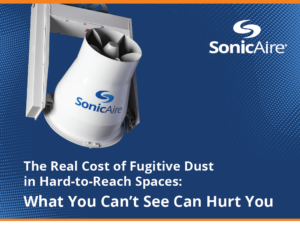
GET YOUR FREE GUIDE:
The Real Cost of Fugitive Dust in Hard-to-Reach Spaces
What You Can’t See Can Hurt You
To help protect your workplace, we’ve compiled the following resource, The Real Cost of Fugitive Dust in Hard-to-Reach Spaces: What You Can’t See Can Hurt You. In it, we identify seven ways fugitive dust is likely impacting your facility and its profitability.
These costs go beyond housekeeping and explain why you should be preventing dust buildup to protect the bottom line, not just to stay in compliance.

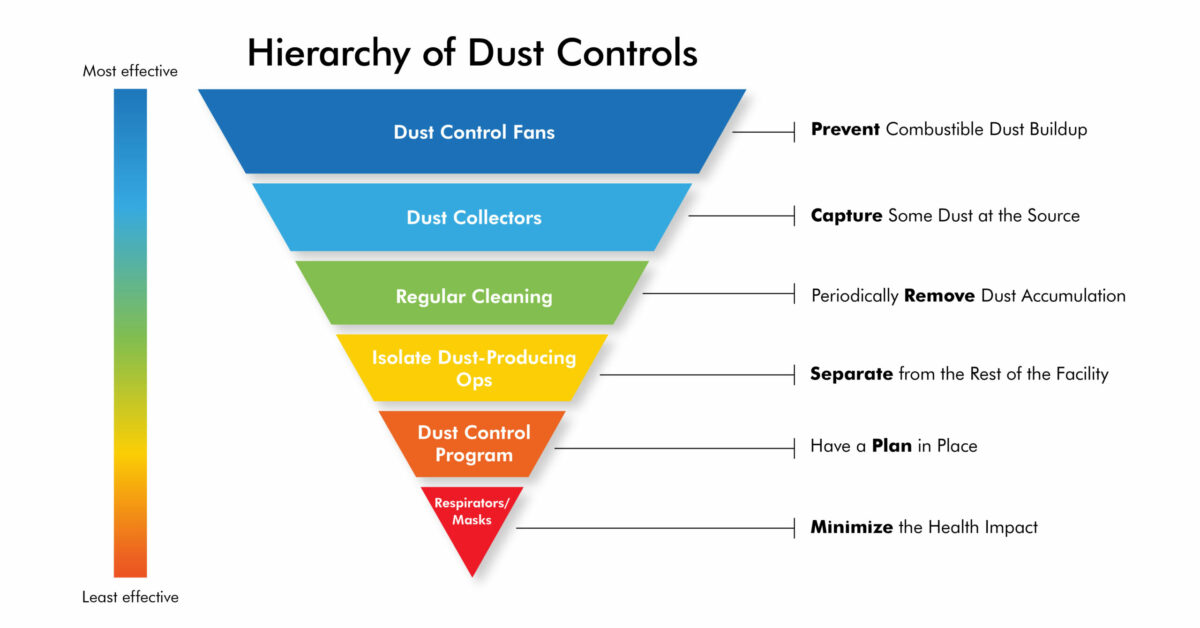
 Dust Control Program [Administrative Controls] – The most obvious example of this is yellow-painted pathways in facilities. You can’t eliminate forklifts for moving material throughout the building. But you can control how and where people walk. Signs are another method of warning and guiding people to work in a particular manner.Unfortunately, there is little that administrative controls can do to change employees’ work that will impact fugitive dust production and buildup. Fugitive dust is a natural by-product of specific processes. A control program,
Dust Control Program [Administrative Controls] – The most obvious example of this is yellow-painted pathways in facilities. You can’t eliminate forklifts for moving material throughout the building. But you can control how and where people walk. Signs are another method of warning and guiding people to work in a particular manner.Unfortunately, there is little that administrative controls can do to change employees’ work that will impact fugitive dust production and buildup. Fugitive dust is a natural by-product of specific processes. A control program,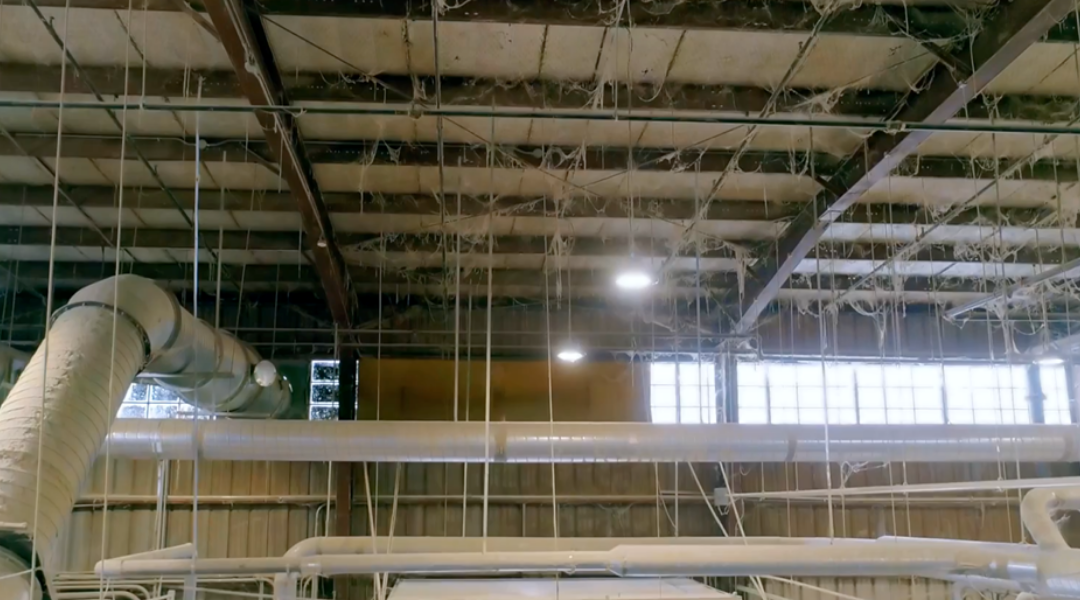 Regular Cleaning [Substitution] –
Regular Cleaning [Substitution] – 